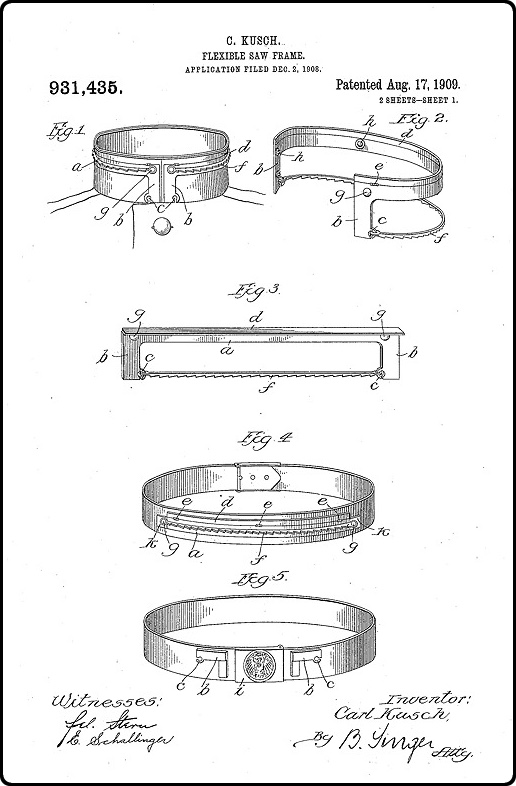Patents
Seated Sleeping Aid
Full patent here.

Posted By: Paul - Thu Oct 03, 2024 -
Comments (3)
Category: Inventions, Patents, Medicine, Sleep and Dreams, 1910s
John F. Dreyer, Three-Dee Glasses Tycoon




Posted By: Paul - Fri Sep 27, 2024 -
Comments (0)
Category: Inventions, Patents, Movies, 1950s
Neck-Exercising Device
Patent No. 4,832,333

Posted By: Alex - Mon Sep 23, 2024 -
Comments (0)
Category: Exercise and Fitness, Patents, 1980s
Purse Converts to Jacket—Or Vice Versa!
Full patent here.

Posted By: Paul - Thu Sep 19, 2024 -
Comments (1)
Category: Inventions, Patents, Purses, Wallets, Billfolds, Poke Sacks and Other Carryable Containers, Clothing, 1980s
A method for irradiating radioactive radiation
Patent No. 6,415,009 (granted in 2002) is titled, "Method for producing a coiled body for irradiating radioactive radiation."What could it mean to irradiate radioactive radiation? When I came across the phrase I had to stop and think about it.
The text of the patent unfortunately didn't provide any clarification, although it did reveal that all this irradiating is being done in the context of brachytherapy (from wikipedia: "a form of radiation therapy where a sealed radiation source is placed inside or next to the area requiring treatment").
The phrase "radioactive radiation" actually does make sense to me. Radiation is a catch-all term for the emission of any kind of electromagnetic energy. So 'radioactive radiation' would be high-energy or ionizing radiation, as opposed to, say, low-energy heat radiation.
But I'm still confused what they mean by irradiating radioactive radiation? Does it mean to make radioactive radiation even more radioactive?
Or are they misusing the word 'irradiate'? My dictionary indicates that 'irradiate' means either to be exposed to radiation or to be illuminated by radiation. The sun radiates or emits light, and the earth is irradiated by its light.
So did the patentees mean 'emitting' rather than 'irradiating'? I'm just not sure. If anyone can figure out what the phrase means, let me know.

Posted By: Alex - Mon Aug 26, 2024 -
Comments (3)
Category: Science, Atomic Power and Other Nuclear Matters, Patents
Underwear-concealed survival saw
If you find yourself held hostage, there's a newly patented invention (No. 12,059,045) that may help you escape to freedom. It's an underwear-concealed survival saw.The flexible saw can be concealed in almost any undergarment ("undershirt; boxers/briefs, camisole or brassiere"). It's possible to retrieve the saw even while wearing handcuffs. Then you can use it to cut through zip ties, ropes, wood, or even light metals.


The underwear-concealed saw bears some resemblance to an oddball invention we've previously posted about: the collar saw of Carl Kusch.

Posted By: Alex - Sat Aug 24, 2024 -
Comments (4)
Category: Fashion, Patents
Electric Dumb Bell
Couldn't you achieve the same thing by just sticking your finger in a wall socket while exercising?Full patent here.


Posted By: Paul - Sun Aug 18, 2024 -
Comments (1)
Category: Exercise and Fitness, Patents, 1920s, Bodybuilding, Pain, Self-inflicted and Otherwise
Novelty Wig
FINALLY, I can achieve the effect so often seen in cartoons and gag panels!Full patent here.

Posted By: Paul - Fri Aug 16, 2024 -
Comments (4)
Category: Wigs, Hairpieces, Fake Eyelashes, Implants, and other Prosthetics, Patents, 1920s, Pranks
Double-standard DWI-rules game
Emil Richard Rossi was granted a patent (No. 6,412,777) in 2002 for his "Double-standard DWI-rules" board game.One purpose of the game was to teach players about drunk-driving laws and the financial consequences of drunk driving. Its second purpose was to demonstrate the "double-standard" of drunk-driving enforcement. Or, as he put it, the "Special treatment for drunk-driving offenders according to their Social Status."
Sounds like Rossi had a bone to pick with the way drunk-driving laws are enforced.
No surprise, his game was never produced by a commercial board game manufacturer, but according to boardgamegeek.com he did self-publish the game. So perhaps a copy of it might be available in a second-hand store somewhere.

From his patent description:
The object of the game disclosed herein, is to provide amusement for the players while they acquaint themselves with the financial liability incurred by being arrested for driving drunk. It is also is an object of the game is to provide amusement for the players while they acquaint themselves with the behind the Scene manipulations resulting in Special treatment for drunk-driving offenders according to their Social Status.


Posted By: Alex - Wed Aug 14, 2024 -
Comments (1)
Category: Games, Inebriation and Intoxicants, Police and Other Law Enforcement, Patents, 2000s, Cars
The Guitar-Xylophone
A guitar with an attached xylophone! Perfect for one-man bands!Original patent here.



Posted By: Paul - Sat Aug 10, 2024 -
Comments (0)
Category: Inventions, Chindogu, Patents, Music, 1920s

| Who We Are |
|---|
| Alex Boese Alex is the creator and curator of the Museum of Hoaxes. He's also the author of various weird, non-fiction, science-themed books such as Elephants on Acid and Psychedelic Apes. Paul Di Filippo Paul has been paid to put weird ideas into fictional form for over thirty years, in his career as a noted science fiction writer. He has recently begun blogging on many curious topics with three fellow writers at The Inferior 4+1. Contact Us |




